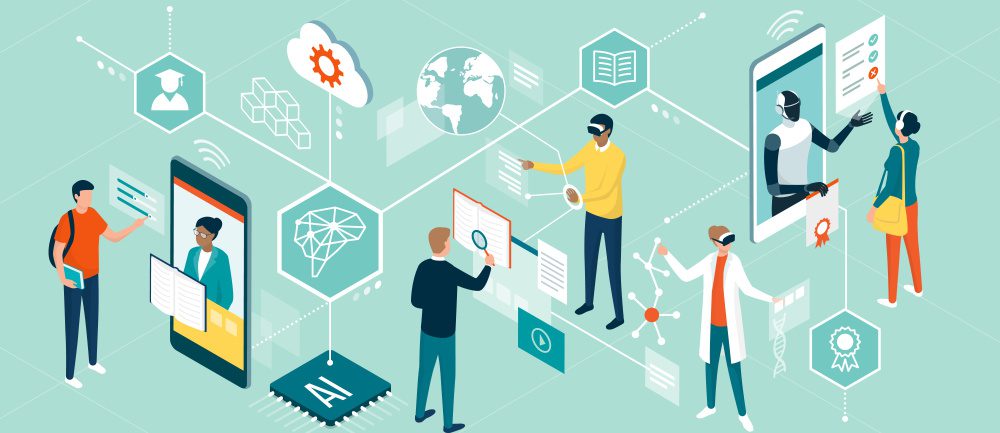How VR can accelerate your L&D strategy
- 6 Min Read
Virtual reality (VR) technology is revolutionizing the way organizations approach learning and development (L&D). By providing a more engaging and immersive learning experience, VR can increase retention and engagement among employees. HR leaders play a key role in implementing VR in their organization’s digital L&D strategy. This involves choosing a technology partner and promoting a […]
- Author: HRD Connect
- Date published: Feb 7, 2022
- Categories

Virtual reality (VR) technology is revolutionizing the way organizations approach learning and development (L&D). By providing a more engaging and immersive learning experience, VR can increase retention and engagement among employees. HR leaders play a key role in implementing VR in their organization’s digital L&D strategy. This involves choosing a technology partner and promoting a culture of innovation and continuous learning within the organization. By doing so, organizations can reap the benefits of VR training, such as increased employee productivity, reduced training costs, and a measurable return on investment.
However, whilst there are benefits, implementing VR technology may feel like a challenging prospect. Securing buy-in, locating the right partner, and ingraining VR-enabled learning into workplace culture are all important steps on this journey. Let’s examine how to ensure your investments in VR result in measurable L&D improvements, rather than becoming yet another piece of shelfware.
How to make VR a part of your L&D strategy
Implementing VR into your L&D strategy can seem like a daunting task, but with careful planning and consideration, it can be a smooth and rewarding process. Here are the key steps.
Assess your needs
The first step is to assess your organization’s specific needs and goals for VR training. Consider factors such as the skills you want to develop, the type of training that would be most effective, and the budget you have available for implementation. Ensure that you have sufficient funding in place to purchase the necessary technology and to develop high-quality training content. Additionally, check that your technology infrastructure is up to the task of supporting VR training, including having the necessary hardware, software, and internet connectivity.
Choose your VR partner
Once you have a clear understanding of your needs, it’s time to choose a technology partner that meets those needs and has a proven track record of success in VR training. Consider factors such as the technology’s compatibility with your existing systems, ease of use, and customer support.
Develop your content
Work with your partner to develop engaging and effective training content that meets the needs of your organization and its employees. Ensure that the content aligns with your overall L&D goals and is tailored to the specific skills and knowledge you want to develop.
Run and constantly iterate your VR training
Roll out your VR training to your workforce, ensuring that you have the necessary technology and resources in place to support their training experience. Consider providing training and support for using the technology itself to ensure a smooth transition to VR training. Trial different programs, seek out consistent feedback from your team, and work to implement their suggestions. There are continued opportunities to innovate and trial new ideas with the help of your team.
How to choose your VR L&D partner
When choosing a technology partner, HR leaders should consider several important criteria to ensure they find the right fit for their organization’s needs.
- Firstly, it is important to consider the technology partner’s experience and expertise in the L&D industry. A partner with a strong track record of delivering successful training programs and a deep understanding of the challenges and opportunities of the L&D space can provide valuable insights and support.
- Secondly, HR leaders should consider the technology partner’s technology offerings. This includes the types of devices and software they provide, as well as the level of customization and support they offer.
- HR leaders should also consider the level of resources and support provided by the VR technology partner. This includes access to technical support and customer service, as well as resources such as training materials and tutorials. Working with a VR technology partner can provide HR leaders with access to a wealth of expertise and resources that can help them implement VR effectively and achieve their goals.
Working with a technology partner provides HR leaders with a competitive advantage by enabling them to tap into the latest VR technology and innovations. This can help HR leaders stay ahead of the curve and stay competitive in an ever-changing L&D landscape. With the right technology partner, HR leaders can create engaging, effective training programs that deliver measurable results for their organizations.
Creating a culture of innovative learning
Encouraging the workforce to embrace this technology is an important step in maximizing the benefits of a VR L&D strategy. One effective approach is to make this type of immersive training a part of the larger organizational culture of innovation and continuous learning. HR leaders can do this by promoting a culture that values and encourages the use of new technologies, including VR, to enhance learning and development.
Another strategy is to make the training easily accessible and convenient for employees. This may involve providing devices and equipment in the workplace or offering training as part of a flexible, online learning program. HR leaders can also promote training by highlighting its benefits, such as increased engagement and retention, and sharing success stories from other organizations that have successfully implemented VR in their L&D programs.
Additionally, HR leaders can incentivize the use of such technology by offering rewards or recognition for those who participate in VR training. This could include recognition in company newsletters, promotions, or other forms of recognition that align with the organization’s culture and values. There will likely be early adopters keen to champion this technology in exchange for these different types of recognition.
To encourage the workforce to embrace VR technology, HR leaders must also create a supportive and inclusive environment. This means fostering a culture of collaboration and continuous learning, where employees feel comfortable sharing their experiences and feedback. By promoting a culture of innovation and continuous learning, HR leaders can create an environment that is more likely to embrace and make the most of VR technology in the L&D strategy.
The importance of VR in L&D
VR offers a unique and immersive learning experience that traditional training methods cannot match. The major advantage of this training is that it allows learners to experience realistic scenarios and environments, enhancing their engagement and facilitating a deeper understanding of the subject matter. Employees can practice and apply skills in a safe and controlled environment, leading to increased competence and confidence in their abilities.
In addition to enhanced engagement and understanding, VR training also offers other key benefits. For example, it allows for highly personalized and interactive training, which can lead to improved retention of information. Moreover, it can save time and money compared to traditional training methods, as it eliminates the need for travel and reduces the need for physical resources, such as materials and equipment.
________________
HRD Connect delivers high-quality analysis, intelligence, and resources for senior HR leaders. We provide invaluable insights and exclusive interviews examining the most innovative practices that help HR leaders meet the challenges they face, including strategy & leadership, talent, rewards & benefits, digital transformation, DE&I, and employee engagement.
Access the latest case studies, thought leadership, and HRD Live Podcast episodes.








